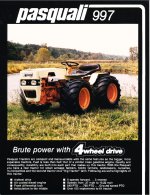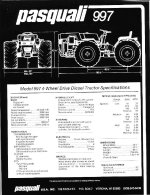284 International
Veteran Member
- Joined
- Jun 28, 2010
- Messages
- 1,466
- Tractor
- International Harvester 284
Awhile ago my regular browsing of various classified services led me to a new tractor. It's a Pasquali 997, made in Italy sometime in the late 1970s/early 80s. It's not a Yanmar, but since it is in the stable with nearly all Yanmar machines, comparisons were inevitable, and I thought it might be interesting to people here.
It's an odd machine, obviously built by a company with a different set of design intentions and priorities than traditional tractor manufacturers. To wit, the machine is, apart from massive width due to the tires, perhaps a bit smaller than my YM1401D. Their wheelbases are the same, the Pasquali sits a little bit lower overall, and their widths with conventional tires are approximately equal; the Pasquali can be a little bit narrower. Both are diesel powered, gear driven, 4 wheel drive machines. But apart from that, they are more different than similar. With the loader, the Pasquali is a little bit shorter overall than the YM1401D. The seat of the Pasquali is a couple inches lower. For size reference, the tiller on the back of the Yanmar is 42 inches outside to outside, and the box blade on the Pasquali is 66 inches wide. The Pasquali tractor is 60 inches wide with these tires. Both have buckets 47 1/2" wide.
The Pasquali is a center-articulating, permanent 4 wheel drive machine. This unit uses two massive hydraulic cylinders to provide steering power completely hydraulically, though apparently some were made with manual steering. The Ruggerini engine is air-cooled, and massively powerful: The machine is rated at 31 PTO horsepower, more than double my Yanmar! The engine is a wonder, frankly. It is a big twin cylinder, and bangs to life instantly without any preheating from glow plugs or spinning up with compression release. (The engine has compression release levers on the valve cover, but they are not connected by Pasquali.)
The air-cooled aspect is wonderfully appealing to me: It seems that a majority of compact tractors run into engine trouble when their 30 year old radiators finally corrode sufficiently to inhibit cooling. The engines overheat, pop a head gasket, and can ruin the bottom end from the subsequent coolant leak. The air cooled aspect bypasses all these concerns, naturally. The cooling fan is just like a massive lawn mower engine, mounted at the front of the crankshaft with ducting to carry air around the cylinders. It blows copious amounts of air, and a fringe benefit is it dilutes the diesel exhaust since they exit very near one another.
The transmission is a 3 + 1 speed, 3 range transmission yielding a total of 9 ratios forward and 3 in reverse, with a nice assortment of speeds and ratios to be fairly user-friendly for most purposes, within the limitations of gear transmission expectations.
Now it gets strange: The tractor has multiple (3) PTO speeds, not unusual of course. It has a 540 and 750 RPM settings, but then it also has a ground-speed PTO gear, that matches PTO RPM to driveshaft speed. This allows powered trailers to be connected and obtain the same input shaft speed as the rest of the tractor. But there's more:
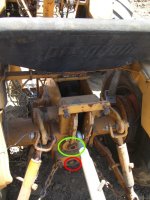
There are actually TWO PTO outputs. The top, circled in green, is a female splined, clockwise rotating PTO shaft. Below, circled in red, is a counterclockwise rotating male splined shaft. Both are capable of the three different PTO settings, though not independently of one another. An adapter slips into the top PTO drive to allow normal 1 3/8" PTO implements to be powered. The rear hitch is a more-or-less conventional Category I hitch.
The control arrangement is the most frustrating aspect of this machine. The stereotype of Italians is that their hands are constantly aflutter with gesticulation; I've never been to Italy, so can't speak about that, but the expectations of their tractor operators would seem to imply it may be accurate. There are two pedals only: A clutch on the left, and a single brake pedal, operating two rear drums brakes. The remainder of the controls are all hand operated, and they are in odd places.
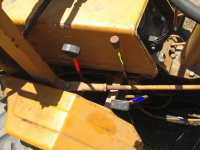
The steering column and part of the steering wheel can be seen in the upper right corner; this is looking at the left side of the machine. The red marked lever activates the front axle's differential lock. (Open differential in the rear, no locking ability) The green marked lever operates the three point lift. The blue marked lever is one of the PTO gear levers, selecting 540, neutral, or 750 RPM. The lift control is horribly obnoxious to me. It is forward and low; difficult to reach even for me, taller than average. It is impossible to reach the lever and look behind at the implement. Additionally, because it is operated by the same hand as the differential lock, it is impossible to both control the implement lift and simultaneously engage the differential lock, as might be required when working with box blade rippers, a heavy 3 point disk, etc.
The right hand operates the gear shifts on the right side of the dash board, with the speed selector and range box. The right hand also operates a mechanical parking brake under the seat (marked blue), while on the left side under the seat is the ground speed PTO control (marked red).
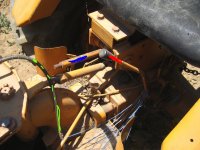
Operating the tractor is odd. With the loader out front, even with the massively heavy box blade out back, the machine steers by swinging the hind end of the tractor around, rather than directing the front of the tractor as does a conventional tractor. The machine also rotates about a pivot at the center of the machine to allow contact over rougher terrain. This provides a very unconventional feeling compared to regular tractors. When using the loader, a normal tractor will arc around the rear tire inside the turn. The articulated machine slides sideways in the rear, around the inside front tire. This feels much different in operation than a regular tractor. The rear of the machine circumscribes an arc wider than the front of the tractor. This isn't better or worse, merely different.
Proponents of the articulating design claim it is more maneuverable than a traditional front steering only tractor. I am unconvinced. Without turning brakes, the two tractors seem to require about the same area to turn, making allowance for the marked difference in width, naturally.
The pulling power of the machine is astonishing. The tractor is claimed to weigh somewhere around 1900 pounds with these tires. The loader adds another 780 lbs. The wide, low pressure but cleated tires have tremendous grip in my conditions, and the massively powerful engine loafs even pulling the large, heavy box blade full of heavy clay soil. The low profile and power steering make it easy to operate around trees and small areas. The wide tires are cumbersome, however, and while they give tremendous stability on side hills, they keep the tractor from being able to drive into its own loader bucket width.
Compared to the similarly sized Yanmar, there are some benefits, and some drawbacks. The huge power in comparison is wonderful. It's more than half again as powerful as a YM240/2000. The air cooled diesel is better, as well. The main shortcomings are stupidity in design, from my perspective. For instance, in spite of the husky engine, the fuel tank is significantly smaller than the Yanmar's. It is barely larger than a regular sized battery. The tank's fuel fill, with the loader, is unreasonably difficult to fill. It sits DIRECTLY under the crossmember for the loader, with barely 4 inches of clearance. The hood will not raise up much when mounted with a loader, making access virtually impossible. The Yanmar, in contrast, is easily accessed at all of the service points. The Yanmar is easier to use: The arrangement of some controls to the feet (like the differential lock) eases operator load, and the lift control at the right hip lets the operator see the implement while also manipulating its height.
The Pasquali is not amenable to this; it somewhat makes up for that trait through sheer muscularity: If the tractor doesn't bog down there's no reason to reduce the load. It makes finish grading difficult, however. I have not yet run the machine for hour after hour, so am still adjusting to the specific techniques to best utilize the tractor. It is definitely less user friendly, but has some strengths that other machines do not. It seems to be well built and tailored to certain techniques of farming, but is not something I have felt to be "better" than traditional machines. Stupid shortcomings like the fuel fill are utterly infuriating, and would not be seen on any other factory designed loader for a tractor, while wonderful traits like the engine make it magnificent.
It's an odd machine, obviously built by a company with a different set of design intentions and priorities than traditional tractor manufacturers. To wit, the machine is, apart from massive width due to the tires, perhaps a bit smaller than my YM1401D. Their wheelbases are the same, the Pasquali sits a little bit lower overall, and their widths with conventional tires are approximately equal; the Pasquali can be a little bit narrower. Both are diesel powered, gear driven, 4 wheel drive machines. But apart from that, they are more different than similar. With the loader, the Pasquali is a little bit shorter overall than the YM1401D. The seat of the Pasquali is a couple inches lower. For size reference, the tiller on the back of the Yanmar is 42 inches outside to outside, and the box blade on the Pasquali is 66 inches wide. The Pasquali tractor is 60 inches wide with these tires. Both have buckets 47 1/2" wide.
The Pasquali is a center-articulating, permanent 4 wheel drive machine. This unit uses two massive hydraulic cylinders to provide steering power completely hydraulically, though apparently some were made with manual steering. The Ruggerini engine is air-cooled, and massively powerful: The machine is rated at 31 PTO horsepower, more than double my Yanmar! The engine is a wonder, frankly. It is a big twin cylinder, and bangs to life instantly without any preheating from glow plugs or spinning up with compression release. (The engine has compression release levers on the valve cover, but they are not connected by Pasquali.)
The air-cooled aspect is wonderfully appealing to me: It seems that a majority of compact tractors run into engine trouble when their 30 year old radiators finally corrode sufficiently to inhibit cooling. The engines overheat, pop a head gasket, and can ruin the bottom end from the subsequent coolant leak. The air cooled aspect bypasses all these concerns, naturally. The cooling fan is just like a massive lawn mower engine, mounted at the front of the crankshaft with ducting to carry air around the cylinders. It blows copious amounts of air, and a fringe benefit is it dilutes the diesel exhaust since they exit very near one another.
The transmission is a 3 + 1 speed, 3 range transmission yielding a total of 9 ratios forward and 3 in reverse, with a nice assortment of speeds and ratios to be fairly user-friendly for most purposes, within the limitations of gear transmission expectations.
Now it gets strange: The tractor has multiple (3) PTO speeds, not unusual of course. It has a 540 and 750 RPM settings, but then it also has a ground-speed PTO gear, that matches PTO RPM to driveshaft speed. This allows powered trailers to be connected and obtain the same input shaft speed as the rest of the tractor. But there's more:

There are actually TWO PTO outputs. The top, circled in green, is a female splined, clockwise rotating PTO shaft. Below, circled in red, is a counterclockwise rotating male splined shaft. Both are capable of the three different PTO settings, though not independently of one another. An adapter slips into the top PTO drive to allow normal 1 3/8" PTO implements to be powered. The rear hitch is a more-or-less conventional Category I hitch.
The control arrangement is the most frustrating aspect of this machine. The stereotype of Italians is that their hands are constantly aflutter with gesticulation; I've never been to Italy, so can't speak about that, but the expectations of their tractor operators would seem to imply it may be accurate. There are two pedals only: A clutch on the left, and a single brake pedal, operating two rear drums brakes. The remainder of the controls are all hand operated, and they are in odd places.

The steering column and part of the steering wheel can be seen in the upper right corner; this is looking at the left side of the machine. The red marked lever activates the front axle's differential lock. (Open differential in the rear, no locking ability) The green marked lever operates the three point lift. The blue marked lever is one of the PTO gear levers, selecting 540, neutral, or 750 RPM. The lift control is horribly obnoxious to me. It is forward and low; difficult to reach even for me, taller than average. It is impossible to reach the lever and look behind at the implement. Additionally, because it is operated by the same hand as the differential lock, it is impossible to both control the implement lift and simultaneously engage the differential lock, as might be required when working with box blade rippers, a heavy 3 point disk, etc.
The right hand operates the gear shifts on the right side of the dash board, with the speed selector and range box. The right hand also operates a mechanical parking brake under the seat (marked blue), while on the left side under the seat is the ground speed PTO control (marked red).

Operating the tractor is odd. With the loader out front, even with the massively heavy box blade out back, the machine steers by swinging the hind end of the tractor around, rather than directing the front of the tractor as does a conventional tractor. The machine also rotates about a pivot at the center of the machine to allow contact over rougher terrain. This provides a very unconventional feeling compared to regular tractors. When using the loader, a normal tractor will arc around the rear tire inside the turn. The articulated machine slides sideways in the rear, around the inside front tire. This feels much different in operation than a regular tractor. The rear of the machine circumscribes an arc wider than the front of the tractor. This isn't better or worse, merely different.
Proponents of the articulating design claim it is more maneuverable than a traditional front steering only tractor. I am unconvinced. Without turning brakes, the two tractors seem to require about the same area to turn, making allowance for the marked difference in width, naturally.
The pulling power of the machine is astonishing. The tractor is claimed to weigh somewhere around 1900 pounds with these tires. The loader adds another 780 lbs. The wide, low pressure but cleated tires have tremendous grip in my conditions, and the massively powerful engine loafs even pulling the large, heavy box blade full of heavy clay soil. The low profile and power steering make it easy to operate around trees and small areas. The wide tires are cumbersome, however, and while they give tremendous stability on side hills, they keep the tractor from being able to drive into its own loader bucket width.
Compared to the similarly sized Yanmar, there are some benefits, and some drawbacks. The huge power in comparison is wonderful. It's more than half again as powerful as a YM240/2000. The air cooled diesel is better, as well. The main shortcomings are stupidity in design, from my perspective. For instance, in spite of the husky engine, the fuel tank is significantly smaller than the Yanmar's. It is barely larger than a regular sized battery. The tank's fuel fill, with the loader, is unreasonably difficult to fill. It sits DIRECTLY under the crossmember for the loader, with barely 4 inches of clearance. The hood will not raise up much when mounted with a loader, making access virtually impossible. The Yanmar, in contrast, is easily accessed at all of the service points. The Yanmar is easier to use: The arrangement of some controls to the feet (like the differential lock) eases operator load, and the lift control at the right hip lets the operator see the implement while also manipulating its height.
The Pasquali is not amenable to this; it somewhat makes up for that trait through sheer muscularity: If the tractor doesn't bog down there's no reason to reduce the load. It makes finish grading difficult, however. I have not yet run the machine for hour after hour, so am still adjusting to the specific techniques to best utilize the tractor. It is definitely less user friendly, but has some strengths that other machines do not. It seems to be well built and tailored to certain techniques of farming, but is not something I have felt to be "better" than traditional machines. Stupid shortcomings like the fuel fill are utterly infuriating, and would not be seen on any other factory designed loader for a tractor, while wonderful traits like the engine make it magnificent.
Last edited:
